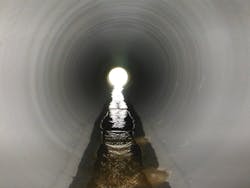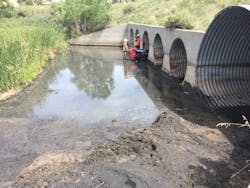Structurally Rehabilitating Bridge-Supporting Culverts in Colorado
When an inspection in Castle Rock, Colorado, determined repairs were needed for a set of large-diameter culverts supporting a primary artery over a designated flood plain, with propensity to erosion, careful engineering analysis was conducted to select and implement the best solution for the situation.
Plum Creek Parkway, a primary artery, crosses a bridge over Sellers Gulch, which is supported by six large-diameter, parallel culverts, each spanning 172 ft.
The Colorado DOT Bridge Division is responsible for maintaining the structure and determined that the supporting culverts needed repair after a Bridge Rating Inspection. Because they support a primary arterial bridge, structural rehabilitation was required. The town of Castle Rock applied for a federal funded grant for the crossing and worked with CDOT to obtain federal funding for the bridge rehabilitation. The design was done per CDOT standards and specifications to comply with Federal regulations on funding. It was determined that the condition of the various CMPs and the available budget could be best aligned through fully structural rehabilitation of three of the culverts, and invert relining of the remaining three.
The three pipes designated for relining were 90 in. to 145 in. in diameter, each spanning 172 ft underneath the roadway. Engineering analysis was conducted to determine the relining thickness of 2 in., using the CentriPipe centrifugally cast concrete pipe (CCCP) method of applying fine aggregate composite concrete (FACC) to the interior walls. Permacast PL-8,000, the FACC selected for the project, is formulated specifically for the CentriPipe system to achieve the best adhesion, the right thixotropy, thin-shell toughness, low permeability, and other properties desirable in an FACC for fully structural centrifugal application.
All work was completed without diverting traffic by working from underneath the roadway. Equipment was moved down an embankment on a vehicle tracking pad. An area was excavated to create a stationary pad for staging the pump and mixer, and other needed equipment and materials. A 230-ft hose was required to reach from the staging area to the end of each culvert. The biggest challenge of the project was diverting a significant amount of water. Bypass hoses and pipes were used to channel the flow through the 145-in. pipe, and back out to an existing wetland area. The crew was able to continually capture the water from both the inlet side and from the lateral storm line (entering the bridge culvert pipe at the last culvert end), moving the bypass hose, while simultaneously spin-casting the interior of the pipe, to complete the application. The project was a collaboration between CDOT, the town of Castle Rock, Wilson & Co. Inc., American West and AP/M Permaform. The rehabilitated pipes are smooth from end-to-end, watertight and fully structural, extending the life and ensuring the safety and integrity of the existing bridge.

